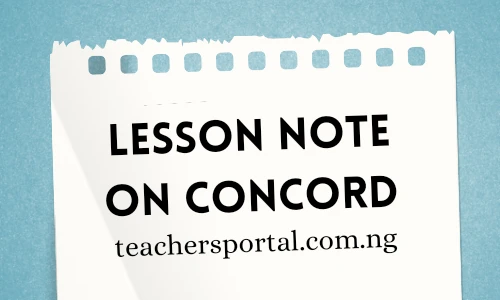Behaviorial Objectives
By the end of the lesson, students will be able to:
- Understand the concept of concord.
- Identify the subject and verb in a sentence.
- Use singular and plural verbs correctly in sentences.
Instructional Materials
- Whiteboard or flipchart
- Markers/pens
- Pictures or drawings of singular and plural objects (optional)
- Worksheet with incomplete sentences
Content
- Introduction (5 minutes):
- Start by singing a song or playing a game that involves using singular and plural words (e.g., “If You’re Happy and You Know It”).
- Briefly introduce the concept of concord as “making words friends” in a sentence. Explain that they need to agree with each other for the sentence to sound right.
- Activity: Identifying Subjects and Verbs (10 minutes):
- Write a simple sentence on the board (e.g., “The cat sleeps on the rug”).
- Ask students to identify the main word (the cat) and explain it is the subject of the sentence (who/what the sentence is about).
- Point to the verb (“sleeps”) and explain it tells what the subject is doing.
- Repeat this activity with a few more sentences, both singular and plural (e.g., “The birds fly high.”).
- Making Friends: Singular and Plural Verbs (15 minutes):
- Introduce the concept of singular and plural verbs using pictures or drawings. Show pictures of a single object (e.g., one apple) and multiple objects (e.g., three apples).
- Explain that singular verbs are used for one thing, while plural verbs are used for more than one thing.
- Give examples:
- “The apple is red.” (singular subject – singular verb)
- “The apples are red.” (plural subject – plural verb)
- Play a game: Say a subject (e.g., dog, cats) and students respond with the correct verb form (e.g., barks, meow).
- Practice Makes Perfect! (10 minutes):
- Distribute worksheets with incomplete sentences where students need to choose the correct singular or plural verb form.
- Alternatively, write incomplete sentences on the board and have students come up and fill in the blanks with the correct verbs.
- Encourage peer-to-peer checking to solidify understanding.
- Conclusion (5 minutes)
- Briefly review the concept of concord.
- Have students share what they learned about “making words friends” in sentences.
- End the lesson with a quick recap activity, repeating the game from step 3 or singing a song that reinforces using singular and plural forms correctly.
Differentiation
- For younger students, focus on identifying singular and plural nouns instead of verbs.
- For advanced students, introduce more complex concepts like subject-verb agreement with collective nouns (e.g., The team is practicing.).
- Provide additional support to students who need it throughout the lesson.
Assessment
- Observe student participation in activities and discussions.
- Review worksheets (if used) or completed sentences on the board.
- Ask individual students to identify subjects and verbs in given sentences.
